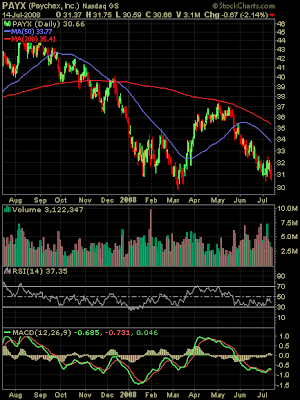 Welcome to the July 15, 2008 edition of investing carnival. I was fortunate to draw this week's Carnival following a tough week in the market. One could really say the weeks have been tough since October of last year.
Welcome to the July 15, 2008 edition of investing carnival. I was fortunate to draw this week's Carnival following a tough week in the market. One could really say the weeks have been tough since October of last year.
Since the markets have not been too kind to investors, I thought the first post should be from one of our doctors. Maybe this will provide the medicine for a better week ahead. So with that enjoy the following submissions from this past week.
Retirement Planning
Jose DeJesus MD presents
Drawing on Your Retirement Funds posted at
Physician Entrepreneur. Some useful tips if one is nearing retirement.
Ben Dinsmore presents The Roth 401K Can Accelerate Your Retirement Savings posted at Trees Full of Money, saying, "We should all be so lucky, but if you are among the few who routinely “max out” their yearly 401k contributions, you definitely need to know about the Roth 401k."
Dividend Investing
Dividend Growth Investor presents McDonald's Corporation (MCD) Dividend Analysis posted at Create Rising Passive Income From Dividend Paying Stocks, saying, "I think that MCD is currently overvalued at a P/E of 27 and a payout ratio of over 75%. The only positive is the solid dividend yield and above average dividend growth. I would consider initiating a long position in MCD on dips below $40."
Dividends4Life presents Stock Analysis: Exxon Mobil Corp (XOM) posted at Dividends 4 Life, saying, "Stock Analysis of Exxon Mobil Corp (XOM)"
Bullish Dividends presents
Dividend Stock Analysis: Great-West Lifeco Inc (TSE: GWO) posted at
Traders Corner, saying, "A Stock analysis of Great-West Lifeco Inc (TSE: GWO) to see if it's a good dividend based investment."
Slackerwealth presents Procter and Gamble, A Case for Going Long posted at A Slacker's Quest for His First Million, saying, "A bullish case for dividend stalwart Procter & Gamble."
Stockaholic presents Advantage Energy Income Fund (TSE: AVN.UN) posted at Traders Corner, saying, "Stock Analysis for Advantage Energy Income Fund"
Investing Screens
The Dividend Guy presents Stock Screens are not Buy Screens posted at The Dividend Guy Blog, saying, "Using stock screen as a stock buy generator is not a good idea. Here are my thoughts on the subject."
Sean presents
The Best Free, Online ETF Screener? posted at
Financial Ramblings.
Investing
Declan Fallon presents Where to start? posted at Fallond Trade history.
Steve Faber presents - Stock Market Terms – The Top10 Market Terms You Need to Know (Part 1) posted at DebtBlog.
The Shark Investor presents I'd Be The Growlingest Bear on the Internet If Only I Were a Bear posted at The Shark Investor.
Geoffrey presents Want to Hold Foreign Currencies Instead of US Dollars? posted at Wealth Monkeys.
Declan Fallon presents Strategy lab: Buy 2% gap - Sell on 10% gain posted at Zignals blog.
Investing Angel presents The 2008 Election And The Stock Market » Free Stock Market Investing Tips posted at Stock Tips, saying, "Your investment decisions right now may largely depend on who
you think will win the 2008 election."
Wealth Accumulation
Silicon Valley Blogger presents Help Your Kids Get Rich: Invest Early posted at The Digerati Life.
Dorian Wales presents Teach Your Kids Basic Finance and Economics with Monopoly - 11 Valuable Lessons posted at The Personal Financier, saying, "11 lessons to teach our kids drawn from a monopoly game I just finished"
Larry Russell presents Living Expense Tracking Methods posted at Pasadena Financial Planner.
Real Estate
Joe Manausa presents
Understanding Trends In Real Estate posted at
Tallahassee Real Estate Blog, saying, "Actual inventory trend analysis helps us to understand the overall movement of our residential inventory over a period of time. Of all the trends in real estate that we study, inventory trends are the most important. The longer the period of time that we study, the less that “noise” affects our view."
Alternative Investments
Neelakantha presents Top 50 Useful Financial Apps for Your iPhone or Blackberry posted at Currency Trading.net. With the introduction of the second generation iPhone maybe this article is for you. If you truly need to stay connected in the wireless world, some of the applications may benefit you.
David presents
If I Was Going To Start Up A Day Spa posted at
Sugar Salon, saying, "For several years, I dreamt of opening my day spa. I would spend hours in my 10×10 cubicle planning the service menu, the decor, the marketing theme, the perfect location. I spent zero hours thinking of managing staff, bookkeeping, dealing with plumbing issues."
That concludes the third carnival edition. Submit your blog article to the next edition of Investing Carnival using our carnival submission form. Past posts and future hosts can be found on The DIV-Net's blog carnival index page.
 A complete list of the Aristocrats and related performance data is contained in the following spreadsheet. The full spreadsheet can be accessed at this link.
A complete list of the Aristocrats and related performance data is contained in the following spreadsheet. The full spreadsheet can be accessed at this link.









































